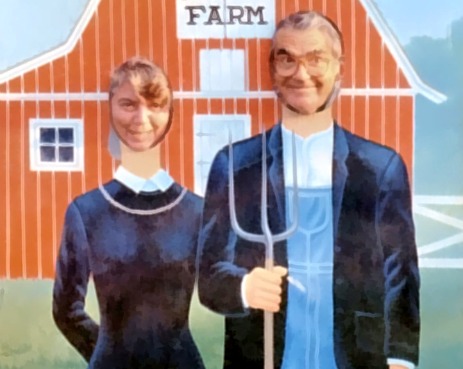The Senate is expected to vote tomorrow on the Food Safety Modernization Act — and possibly pass it by this weekend. Yesterday, we posted our Food Fight participants’ heated — and lengthy — debate over whether S. 510’s provisions will harm small farms or producers. They also discussed whether the Tester-Hagen amendment, which creates exemptions for small farms and food processors that meet certain criteria, mitigated this harm sufficiently without diluting the safeguards for consumers.
Other heavyweights are speaking up. Journalists Michael Pollan and Eric Schlosser, who have extensively covered the industrial food system and its ills, emailed this message to Sen. Jon Tester’s (D-Mont.) office today, Pollan told me: “S. 510 is the most important food safety legislation in a generation. The Tester amendment will make it even more effective, strengthening food safety rules while protecting small farmers and producers. We both think this is the right thing to do.”
Unfortunately, we posted yesterday’s discussion before one of our participants was able to contribute. Her perspective — that of a victim of food-borne illness — was not represented in yesterday’s opus, and so we have reopened the debate (briefly) once more.
 Kathleen Chrismer, food-safety advocate: I offer this as a comment to points made in favor of the Tester amendment. Many have drawn comparisons to previous reform involving food processing and use this as proof that S. 510 will kill small farms and producers. Too much paperwork, too many rules, not enough time, and slim profit margins are common complaints that are supposedly fixed by the Tester amendment. However, let me point to approximately 5,000 deaths that occur every year as a result of food-borne illness. This is not speculation based on what might happen, it’s a fact — food-borne illness kills children, parents, and grandparents.
Kathleen Chrismer, food-safety advocate: I offer this as a comment to points made in favor of the Tester amendment. Many have drawn comparisons to previous reform involving food processing and use this as proof that S. 510 will kill small farms and producers. Too much paperwork, too many rules, not enough time, and slim profit margins are common complaints that are supposedly fixed by the Tester amendment. However, let me point to approximately 5,000 deaths that occur every year as a result of food-borne illness. This is not speculation based on what might happen, it’s a fact — food-borne illness kills children, parents, and grandparents.
Too much paperwork? If small producers are not keeping good records of who they sell to, where they sell it, and how much is being sold, then I can see why they operate on slim profit margins. I don’t think it will be easier for a small producer to retain an attorney to defend them when a food-borne illness victim’s attorney files a complaint in court (followed by all the accompanying paperwork), rather than to have a written plan that shows they are taking the steps necessary to reduce the risk of contamination.
Too many rules? Tell that to the parent of a child who suffered HUS and kidney failure from eating contaminated spinach, contaminated lettuce, or strawberries, etc., and they’ll tell you all about all the rules they have to follow. Rules about when to give their child the medications that keep her kidneys functioning, what the young girl can and cannot eat because the bacteria damaged her pancreas and she is now diabetic, or rules regarding educational accommodations because their child now has learning disabilities due to swelling in her brain — again, as a result of E. coli O157:H7 bacteria. How do you tell the parent of a deceased child that the food that killed him came from a protected class of small producers and processors that aren’t large enough, or sell enough to be held to the rules?
Not enough time? Kyle was only 2 1/2 years old when he died from eating spinach contaminated by E. coli O157:H7; I’m pretty sure that his parents, Jeff and Robyn, would say that wasn’t enough time for their son to live a full and productive life. Listeria-contaminated lettuce gave Stephanie only 2 days with her newborn son; she would give anything be able to spend time with her child, even the countless sleepless hours that are part of parenting.
Time is a relative term for someone like Haylee B. She would rather not dwell on the time she spent in the hospital (14 weeks) when she was 3 years old, and have more time now to do the things other teenage girls do — like learn to drive — but E. coli-contaminated mesclun lettuce grown on a small farm has taken that away from her.
What is the “allowable” number of food-borne illnesses and deaths from a small farm or small producer, and when does that number become too big? What if your child was the “allowable” number, plus one?
 Mark Kastel, co-founder of The Cornucopia Institute and director its Organic Integrity Project: I’m sure all of us in this spirited debate have the deepest compassion for those who have suffered serious illness due to contaminated food.
Mark Kastel, co-founder of The Cornucopia Institute and director its Organic Integrity Project: I’m sure all of us in this spirited debate have the deepest compassion for those who have suffered serious illness due to contaminated food.
But we are really talking about two parallel food production and distribution systems in this country. One is inherently dangerous due to its scale, methodology, and distribution model.
The other depends on an intimate relationship between modest, local/regional owner-operators, who take pride in their work and direct connection with consumers.
No matter what protocols are incorporated, in either system, neither will be 100 percent safe. Even in food that is pasteurized or irradiated, contamination can and will occur subsequent to processing treatment.
We want to make sure that consumers have the right to choose between these two alternative supply systems. Since nothing is 100 percent sure, I for one will gamble with my health, and the health of my family, by continuing to patronize local organic farmers. Weighing the risks, and the benefits of superior quality and nutrition, I think I am making a good investment.
The concern is that this bill, without the Tester amendment, will competitively and economically injure these farmers, probably the safest farmers in our country, and deprive some consumers of this option in the marketplace.
Again, I want to emphasize my sincere concern for those who have suffered greatly as victims of rapacious capitalism as practiced in our food system. Preventing recurrences is certainly an appropriate function of government.
 David E. Gumpert, health and food issues reporter: I’d like to second Mark’s statement. The emotional argument Kathleen makes about the children who have been seriously sickened, or died, from food-borne illness is important. The parents want redress, and they want to ensure that other parents don’t have to go through the same experience.
David E. Gumpert, health and food issues reporter: I’d like to second Mark’s statement. The emotional argument Kathleen makes about the children who have been seriously sickened, or died, from food-borne illness is important. The parents want redress, and they want to ensure that other parents don’t have to go through the same experience.
Unfortunately, the best way to satisfy the emotional upset of the parents who are affected isn’t necessarily to pass new legislation that will likely injure many more people — in this case, the small farms Mark refers to.
I would add that some of the injuries that have resulted from food-borne illness aren’t necessarily a result of an absence of legislation. They are the result of the FDA not doing its job. For example, the FDA knew for years about the problems with the Iowa egg producers, yet didn’t go after them in anything like the aggressive way it has gone after small food producers who have made no one ill.
Let’s not try to satisfy emotionally distraught parents by impinging on the rights of all Americans with draconian legislation.

Jean Halloran, director of food policy initiatives at Consumer Union (publisher of Consumer Reports): David says that the problems have occurred because FDA hasn’t been doing its job. I couldn’t agree more, but that is to me the No. 1 reason why we need to pass S. 510. S. 510 requires FDA to inspect food processors (though not farms) within certain minimum time frames. So if we get an FDA that doesn’t do much — either because we have an administration that doesn’t care, or because Congress has cut the budget — there will be a statutory requirement that FDA do a certain number of inspections. The bill requires high-risk facilities to be inspected at least once every five years, increasing later to once every three years, which doesn’t sound like much until you realize that currently FDA inspects food processors once every 10 years on average.
There ought to be a law, and there could be if we pass S. 510!
 Judith McGeary, founder and executive director of the Farm and Ranch Freedom Alliance: I have never lost a child, but I can imagine the incredible pain it causes. But in the midst of Kathleen’s passion for protecting people, she has made inaccurate assumptions about small-scale farmers and producers.
Judith McGeary, founder and executive director of the Farm and Ranch Freedom Alliance: I have never lost a child, but I can imagine the incredible pain it causes. But in the midst of Kathleen’s passion for protecting people, she has made inaccurate assumptions about small-scale farmers and producers.
Small, sustainable farmers spend their money and time on raising safe, quality food. We don’t have the resources, nor the economies of scale, that the large companies have that enable them to absorb additional regulatory burdens.
I think that Mark’s and David’s comments were both excellent, so I’ll speak simply as someone who is farming right now. I’m a livestock farmer, so I won’t face new regulations under S. 510, but I share the values of many of the small-scale local produce farmers and processors who would be directly impacted by S. 510 (particularly absent the Tester-Hagan amendment).
The highest priority for most local food producers is the health of their customers. I look my customers in the face every time we sell them food. I know their children, and I have watched them grow up on the food we raise. I’ve talked with people who are fighting cancer or diabetes, or whose children have asthma — and for whom high quality food is a matter of survival. Several of the people who buy our food are among my closest friends.
No food is 100 percent safe. That is simply a fact of life. But we eat our own food every day, before it ever reaches a customer or a customer’s child.
There are no “acceptable losses” in my opinion. And that includes losses that are not as obvious as foodborne illness outbreaks. Tens of thousands of children die from cancer every year. How many of those children would have never developed cancer were it not for the poisons being put into our air, water, and food by the industrial agriculture system? How many might have been able to survive their illness if they had access to the best, most nutritious foods possible? The connection is not as direct — and fewer lawsuits result — but it is no less real or painful for their parents, and no less of a loss for our society.
Driving local producers out of business will harm many people, not just the farmers. I do not want myself, my customers, or the thousands of other people who depend on local foods for a healthy option, to be forced to buy the low-quality, questionable food produced by the industrial agriculture system that has harmed so many people.
 Bonnie Azab Powell, Grist food editor: I’m supposed to be moderating, not participating, but I need to chime in here, as this resonates for me personally, as a new mom.
Bonnie Azab Powell, Grist food editor: I’m supposed to be moderating, not participating, but I need to chime in here, as this resonates for me personally, as a new mom.
It’s very difficult to respond to an argument that equates making reasoned exceptions for small farms and processors to sentencing children to death. But the fact is that food is not sterile. We can try to make factories, like Peanut Corp of America, more so, but we shouldn’t be subjecting farms to this sort of misguided treatment, as the industry-led Leafy-Greens Marketing Agreement has been attempting to do, with high fences against deer, bare swathes of dirt around crops instead of pollinator-friendly hedgerows, etc.
Regardless of whether S. 510 passes, with or without the Tester amendment, children — and yes, grandmothers and dads — will continue to die from food-borne illness. I recall a news report from last year of a church barbecue in South Carolina that sickened several people with salmonella. That was most likely due to unsafe food handling — something that would not have been prevented by any of the measures that we have been discussing.
S. 510, simply by giving the watchdog some teeth — increased inspections of high-risk facilities, and authority to recall contaminated food — should cut down on some of the flagrant violations we’ve seen, where manufacturers knowingly sent out tainted food. Yet there will still be plenty of occasions when bacteria winds up where we wish it wouldn’t and doesn’t get killed by cooking.
How do you tell the parents of a diseased child that what “killed him came from a protected class of small producers and processors that aren’t large enough, or sell enough to be held to the rules?” I think you tell them that we make the best rules we can for the common good, but that food and bacteria don’t obey rules. No HAACP plan is going to be 100 percent successful, and enough HAACP plans will indeed kill certain small farms.
I don’t say this lightly. I have an eight-month-old daughter, and I would stab myself in the eye rather than ever see her get sick. Yet I feed her a soft-cooked, runny egg, several days a week. It comes from a small, pasture-based farm that I know very well. Yes, salmonella can be present in small, free-range farms, too, and if I wanted to be 100 percent certain, I’d hardboil those suckers (which I do when I have to buy grocery-store eggs). But then I’d also have to never strap my daughter in her carseat and drive her anywhere: approximately 1,300 kids died in car crashes and 184,000 were injured in a recent year.
Life, and eating, will always involve some risk. The government has a duty to protect us by identifying where those biggest risks are, and doing its job by inspecting, testing, and more importantly punishing such facilities when they flout the law. I would like to see the FDA and USDA trying harder to tackle the sources from whence the majority of this unending plague of pathogens originate: feedlots, CAFOs, and a livestock system that routinely feeds antibiotics to its animals to promote growth, even though doing so has created new and more virulent strains of E. coli and other bacteria.
But until they do, I also want the freedom to be able to opt out of the industrial system and patronize small farms — even ones that are never inspected by the FDA, have no HAACP plan, and meet “only” weak state laws. I agree with Mark — that’s a gamble I am willing to take.
Chrismer: Let me begin by explaining that I am an unpaid volunteer for STOP and have a full-time job. If I can’t answer quickly, it is because of time constraints and not because of disinterest.
Deadly pathogens do not discriminate based on the size of a business. They can and do contaminate foo
ds from the tiniest to the largest producers and processors. Large businesses are not inherently dangerous by virtue of their size, methodology, and distribution model. Yes, they do have the capability of creating a larger food-borne illness outbreak because of volume and wider distribution, but their product gets contaminated the same way that product gets contaminated at very small farms and processing facilities. Furthermore, one could argue that larger entities would practice stricter contamination prevention-strategies because they can cause more damage and because they have a larger public profile and therefore can be identified if a food-borne illness outbreak occurs.
In some areas of the country, consumers may actually know their local farmer and have a level of trust and that’s great for them. However, large portions of the U.S. population live in metropolitan areas and the foods sold at many farmers markets come from many miles away with no connection whatsoever between farmer and consumer. Senator Tester wants to define “local” as food coming from as far as 400 miles away. This defies any rational or reasonable definition of the word “local”.
I have no problem with consumers having the choice of buying food from small, local businesses, corporate giants, or anything in-between. But I do have a problem if the foods have not all been produced under the same food safety requirements. You’re right, food will never be 100 percent safe. But the public expects all food entities, regardless of size, to produce under the same set of food-safety standards to make it as safe as it can be.
When the survival of a business becomes more important than the survival of a human being, we, as a society, have lost our moral compass.



